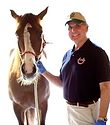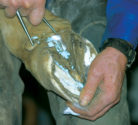Advertise Follow Us
Items Tagged with 'treating thrush'
ARTICLES
This article provides an overview of the causes, diagnosis and treatment of thrush
Read More
Dealing with Thrush and White Line Disease
Combining topical treatments with good hoof care will help you keep these common problems under control
Read More
Tracking, Treating and Thwarting Thrush
To effectively treat thrush, the farrier sometimes needs to play detective to ferret out the root causes of the bacterial infection
Read More









